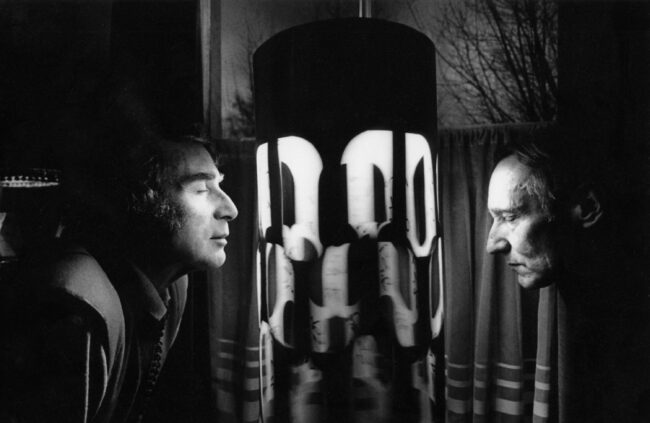Collective Act, a team of leading artists, scientists and philosophers, have created the Dreamachine, a powerful immersive experience exploring the limitless potential of the human mind. Inspired by the 1959 invention created by Brion Gysin, the Dreamachine leads audiences through an immersive environment of light and sound designed to give each viewer a completely individual experience.
If you’ve ever fallen into a trance while staring at a fire or looking out a train window, then you’ve experienced the cerebral stimulation caused by flickering lights observed by artist and inventor Brion Gysin in the 1950s. Inspired by this phenomena, Gysin created a homemade device that used flickering light to create explosions of color across your eyelids when your eyes are closed. Gysin’s hope was that his original Dreamachine would allow consumers to create their own cinematic experiences using the unlimited power of their brains, rather than passively absorbing mass-produced media.

Over 60 years later, Collective Act’s interdisciplinary team of scientists, artists and technologists have transformed Gysin’s original idea into the powerful immersive experience of the 21st century Dreamachine. Following research by the team’s neuroscientists, the team built a communal space with arranged lights and composed sound, designed to stimulate the viewer’s brain into creating the mesmerizing phenomena that originally inspired Gysin.
The project began when Jennifer Crook, who has two decades of experience leading critically acclaimed public projects and award-winning interdisciplinary commissions, conceived the idea for Dreamachine. While overseeing the creative vision and management of the Dreamachine program, Crook built a team of revolutionary minds to bring the project to life.
When Crook imagined the Dreamachine, she wanted to creatively explore the most fundamental of human connections, how humankind perceives the world, beyond the confines of screens or devices.
“The rich kaleidoscopic world of the Dreamachine will come from within, providing a magical insight into the extraordinary potential of your own mind.” Crook said. “To explore one of the greatest remaining mysteries to humankind, all you need to do is to close your eyes.”

The spatial designer for the Dreamachine is Assemble, an interdisciplinary collective, working across architecture, design and art with a hands-on approach and focus on making. While Assemble designed the space, award-winning designer and technologist Dev Joshi delivered the technology behind the Dreamachine experience and oversaw the delivery of the digital elements of the program.
Assemble explained that they were excited to work collaboratively as part of a multidisciplinary team to explore the boundary of consciousness and perception.
“Using a series of large scale prototypes we have designed a setting in which the Dreamachine can be experienced collectively, bringing people together in a shared, multisensory experience.” Assemble said.
Internationally renowned and Grammy nominated electronic artist and producer Jon Hopkins composed the score for the Dreamachine live experience to guide the audience through the immersive journey. Multi-award winning freelance sound designer Christopher Shutt supported Hopkins with the integration of his composition into the Dreamachine.
Jon Hopkins said that it was incredibly exciting to be involved in the Dreamachine and work with the team to create an entirely new type of experience.
“I’ve always been fascinated by the relationship between music and how it impacts your internal world and the images you create in your own mind.” Hopkins said. “I wanted the music to be grounding and a safe, warm space for people as they embark on this powerful experience, both alone and collectively.”

Along with the team of designers and artists, Collective Act collaborated with neuroscientists and professors that study the human mind and the concept of consciousness.
According to neuroscientist Professor Anil Seth, one of the most exciting components of the project is that science and philosophy have been incorporated in every step of the Dreamachine’s creation from its very inception.
Dreamachine functions both as a one of a kind experience for the viewer and a vehicle for a large scale citizen science research project into perceptual diversity. Senior Post-Doctoral Research Fellow at the Centre for Consciousness Science David Schwartzman brought his research into analysis of electoral signals from the brain to contribute to the Dreamachine, while Professor Fiona Macpherson brought her knowledge of the philosophical nature of consciousness and the effects of technological interventions on the senses using VR.
The results of the research will not only be shared with the wider scientific community, but also be made accessible to the whole of the UK. One way that the Dreamachine intends to invite the population to participate in the conversation surrounding science of consciousness is through the Dreamachine School program.
Developed by A New Direction in partnership with the British Science Association and UNICEF UK, the Dreamachine School program offers a variety of exciting ways for schools to engage with the Dreamachine with 30 accredited lesson plans. The idea behind the school program is for young students across the nation to experience the wonder and power of their own minds and to join a nation-wide conversation of science and philosophy.
Dreamachine is one of 10 major creative projects commissioned by UNBOXED: Creativity in the UK. UNBOXED is a nationwide showcase of creative collaboration into science, technology, engineering, art and math with free events and digital experiences to reach millions of schoolchildren. UNBOXED is funded and supported by the four governments of the UK.
For more information about Dreamachine, visit https://dreamachine.world. Free tickets will be available to book from late March 2022.







